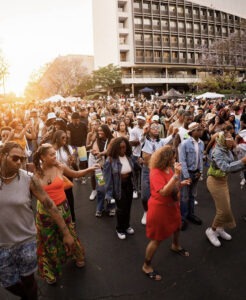APA Los Angeles Presents: Black History Month Profile on Char and Lanie Edwards, Black on the Block
Char and Lanie Edwards
Affiliations:
Black on the Block LLC
What was childhood like for you from an urban planning and community development perspective?
Growing up in a suburb while attending school in the city exposed us to two contrasting environments. The suburbs were quiet and car-dependent, with limited community spaces and few opportunities for interaction outside of the home and there weren’t many people in our neighborhood who we saw ourselves in. In contrast, the city was vibrant, walkable, and diverse, with easy access to public transportation and plenty of cultural and community spaces that fostered connection. While the suburb offered a sense of calmness, it often felt disconnected from cultural movements, whereas the city’s energy showed us how urban planning can create inclusive, engaged communities.
What sparked your passion in the field of urban planning and community development?
Honestly, when we first created Black on the Block to support Black-owned businesses, we weren’t thinking about urban planning or community development in the way we understand it now. It just felt like something we needed to do. We saw a gap in the local community where there were so many talented Black entrepreneurs, but they weren’t getting the exposure or the support they deserved. We wanted to create a space where they could showcase their work and connect with people who valued what they were doing.
Looking back, though, we were designing a space that encouraged connection, fostered inclusivity, and helped businesses thrive which are key principles of urban planning. With venue selection, we focus on the flow of the event, booth placement, and creating an environment that empowered both vendors and attendees. In hindsight, it became clear that we were doing urban planning on a smaller scale, shaping a space for commerce, culture, and community.

How does that passion manifest in your current role?
In our current role, that passion really manifests in how we approach every event. We’re constantly thinking about the bigger picture, not just the physical design of a space, but how it impacts the community as a whole. It’s about creating environments where people feel included, where businesses can grow, and where social connections are nurtured. We draw a lot from the vendor experiences at Black on the Block, especially when it comes to community engagement. It shows us the importance of listening to the people you’re serving, and how a space can either empower or exclude based on how it’s designed. We’re always asking ourselves, “How does this benefit the people who really need it?” and making sure everything we do is driven by the needs of the community, and that we’re creating opportunities for connection, growth, and equity.
Where do you see opportunities in the field to move the needle towards a Beloved Community?
To build a Beloved Community through urban planning and community development, one of the most impactful strategies is designing events and initiatives that circulate the Black dollar and uplift Black-owned businesses. Events like Black on the Block are powerful examples, showcasing local Black entrepreneurs, culture, art, and food, offering both a platform and a physical space for community members to directly support one another while providing Black-owned businesses the visibility they need to grow.
Urban planning plays a crucial role in this by creating spaces that foster these connections, ensuring they reflect the needs and aspirations of the people who call the community home.
What’s one piece of advice you would give to inspire, empower, and influence positive change?
Change really starts with relationships. The most powerful shifts often happen right where we’re at. When we build real connections, work together, and support one another, it creates a ripple effect that can lead to lasting, positive change.







